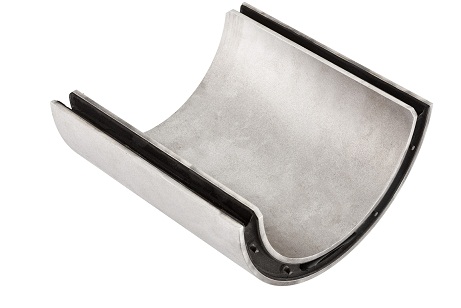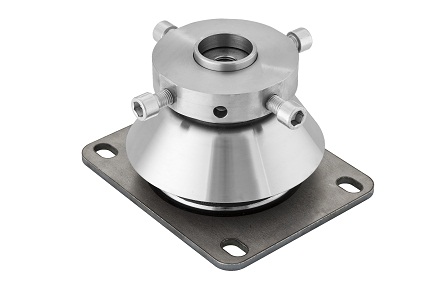A vibration control firm says it has developed its bearings for wind turbines –in the run-up to Husum WindEnergy (September 18 to 22, 2012) — by developing two innovations. A generator bearing and an optimized gearbox bearing can help increase the service life of all components in the drivetrain. “Particularly in large plants of 5 MW and more, the dynamic loads that arise during operation can place a heavy load on the different components,” says Vincent Sambo, Sector Manager for Wind Power at ContiTech Vibration Control.

ContiTech has optimized the half shells’ rubber pad. The two half shells fit into each other, ensuring an even load distribution within the cylindrical bushing. The bearing element with the improved rubber contour provides a service life up to five times longer than that of conventional bearing elements.
Drivetrains are exposed to particularly extreme loads. To ensure smooth operation, it is important to align the rotor, gearbox, and generator with each other. Horizontal or vertical skewing adds a higher burden on the drivetrain and machine carrier components. This in turn shortens the system service life. ContiTech has developed a generator bearing with additional functions so that the generator can be aligned correctly during assembly. The bearing can be moved vertically as well as horizontally. Thanks to this adjustability, the location of the entire drivetrain can be set exactly, and this, in turn, means the load can be reduced to a minimum. The innovative generator bearing and the optimized gearbox bearing lengthen the service life of all components in the drivetrain.
The company is also implementing a new development for the gearbox’s bearing. Half shells are normally used for this job. Two of them form a cylindrical bushing, which is pre-tensioned radially. In conventional elements, irregularities due to the geometry arise in the load to which the rubber pad is exposed. This means that optimum bearing of the gearbox cannot be guaranteed at present. For this reason, ContiTech optimized the half shells’ rubber pad. The two half shells fit into each other, ensuring an even load distribution within the cylindrical bushing. The bearing element with the improved rubber contour provides a service life up to five times longer than that of conventional bearing elements.

The vibration bearing for generators, developed byContiTech, has features that allow aligning the generator correctly during assembly. The bearing can be moved vertically as well as horizontally.
These developments were preceded by comprehensive series of measurements and simulations. “These processes provide us with decisive operating data so that we can create the ideal design for the drivetrain in terms of vibrations,” says Vincent Sambo. “These processes form the basis for development of customized components for wind power stations, thereby further enhancing their performance.” The tests focus on the amplitude and frequency of acceleration on the drivetrain, the low-frequency movements of the components, the isolating performance of the elastic bearings and the natural frequencies of the drivetrain.
The generator and gearbox bearings lengthen the service life of all components in the drivetrain.
“To record the structure-borne noise, for example, we apply a large number of accelerometers to the drivetrain. A total of 95 measuring channels were recorded online by a multi-channel measurement system. This lets us analyze the data and produce an exact simulation later offline,” says Peter Eckwerth, Head of Advanced Development at ContiTech Vibration Control.
In various short-term measurements, the engineers at the company examines the vibration behavior while the network supply is at constant operation, as well as while the wind turbine is starting up, and at a standstill. In this way, the various loads to which wind power stations are exposed are recorded accurately. The exact design of the drivetrain’s components is created on the basis of these comprehensive analyses.
ContiTech Vibration Control
www.contitech.com
Filed Under: Bearings, Components, News




